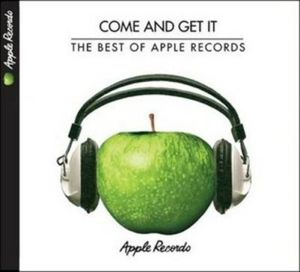
When I was a teenager, I developed an obsession for Apple Records. It was the 1980s, the label wasn’t nearly as collectible as it is now, and most of their releases were relatively inexpensive. One of my favorite hobbies was to make mix tapes of the single releases; it was a fun activity making up a “best-of” for an underrated label with an impressive roster that was overlooked thanks in part to their more-famous owners. I always hoped that one day i would have a higher-fidelity collection of these tapes, but considering the legal hassles of the label and the general apathy to the acts, the likelihood seemed nil.
Jump ahead twenty years, and Come and Get It: The Best of Apple Records is a stepping-stone for a major reissue campaign for the non-Beatles Apple roster. The label launched with a major coup, a one-two punch of international hits, with “Hey Jude” and Mary Hopkin‘s single, “Those Were the Days,” a song of recollection of glory days long passed, and of dreams of expecting the glory days to last forever.
It’s a fitting irony that said song was the label’s first non-Beatles hit, considering what Apple became, in comparison to the hippie idealism its owners hoped to bring to the corporate world. This irony is best evidenced by the transition from this, the first song on the collection, to the song that follows it, James Taylor‘s “Carolina in my Mind,” which failed for Apple, but a rerecorded version became a hit (and one of Taylor’s signature tunes) in 1976, after the label ceased operation. If the success of James Taylor feels like a missed opportunity, it isn’t the only one; Apple would not only pass on such luminaries as Crosby, Stills, and Nash, David Bowie, Gilbert O’Sullivan, Fleetwood Mac, Queen, and, reportedly, Wicked Lester (who would soon become Kiss), but two artists would have big hits shortly after leaving the label, including Billy Preston with “(Will It Go Round In) Circles” and “Nothing from Nothing,” and Hot Chocolate Band with “You Sexy Thing.”
While any discussion of Apple inevitably leads to the label’s failures and short-sighted A&R, what they did release proves that, in actuality, they were a rather diverse label, and Come an Get It: The Best of Apple Records highlights that diversity. You’ll find Reggae (via Hot Chocolate’s cover of “Give Peace a Chance,”), gospel/R&B via Billy Preston, Doris Troy, and Ronnie Spector (here performing a George Harrison composition, “Try Some, Buy Some”), British blues-rock with Jackie Lomax, 70s-era stadium rock with Chris Hodge, Cajun music via The Sundown Playboys, and even Krishna consciousness via Radha Krishna Temple. Then there’s the doomed, record-label cautionary tale of Badfinger, the label’s most enduring and successful non-Beatles act, represented with three songs, “Day After Day,” “Come and Get It,” and pre-name change “Maybe Tomorrow” (as The Iveys).
Listening to these songs thirty to forty years on, one can’t help but wonder, “What happened? These songs are excellent!“ The factors are obvious; the excuses are numerous; the pondering, pointless. Come and Get It: The Best of Apple Records proves that, even though it had seven years to live, Apple Records was no slouch of a label, and that its historical revision is long overdue.